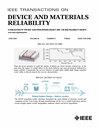高电池密度低压沟槽MOSFET中铝扩散失效机理研究
IF 2.5
3区 工程技术
Q2 ENGINEERING, ELECTRICAL & ELECTRONIC
IEEE Transactions on Device and Materials Reliability
Pub Date : 2022-06-16
DOI:10.1109/TDMR.2022.3183623
引用次数: 0
摘要
本文从工艺设计的角度研究了一种高单元密度的低压沟槽金属氧化物半导体场效应晶体管(MOSFET)。通过P +区域的三维设计和自对准工艺,将实验器件间距减小到0.5 ${\mu }\text{m}$,而硅与金属之间的接触是凸的,而不是传统沟槽MOSFET的凹接触。BV破坏是由于这种结构的特殊性而产生的,这种破坏是由于在金属成形的最后合金步骤中,铝(Al)扩散到漂移区造成的。本文揭示了Al /硅(Si)双扩散机理,并提出了同时抑制反向扩散和正向扩散的精细化表面金属膜。应用所提出的表面金属薄膜,降低了失效的风险,并获得了功能齐全的器件。此外,建议在金属化过程中使用总厚度为50 nm的TiN层作为阻挡层,以提供一定的扩散长度,最终制成的器件的比导通电阻为3.58 $\text{m}\Omega \cdot $ mm2,击穿电压为26.2 V。本文章由计算机程序翻译,如有差异,请以英文原文为准。
Failure Mechanism of Aluminum Diffusion in Low-Voltage Trench MOSFET With High Cell Density
In this paper, a low-voltage trench metal oxide semiconductor field effect transistor (MOSFET) with high cell density is researched on the process design. The experimental device pitch is reduced to 0.5
${\mu }\text{m}$
by three-dimensional (3-D) design of P plus region and self-aligned process, while the contact between silicon and metal is convex rather than the concave in conventional trench MOSFET. BV failure was founded because of the particularity of this structure and the failure is caused by the diffusion of aluminum (Al) into the drift region during the final alloy step in the metal forming process. This paper reveals the mechanism of Al / Silicon (Si) double diffusion and presents the refined surface metal film, which can suppress reverse diffusion and forward diffusion simultaneously. The risk of failure is reduced and functional devices are obtained by the application of the proposed surface metal film. Furthermore, it is recommended to use TiN layers in a total 50 nm as the barrier layer in the metallization process to provide a certain diffusion length and the fabricated device achieves a low specific on-resistance of 3.58
$\text{m}\Omega \cdot $
mm
2
with a corresponding breakdown voltage of 26.2 V eventually.
求助全文
通过发布文献求助,成功后即可免费获取论文全文。
去求助
来源期刊

IEEE Transactions on Device and Materials Reliability
工程技术-工程:电子与电气
CiteScore
4.80
自引率
5.00%
发文量
71
审稿时长
6-12 weeks
期刊介绍:
The scope of the publication includes, but is not limited to Reliability of: Devices, Materials, Processes, Interfaces, Integrated Microsystems (including MEMS & Sensors), Transistors, Technology (CMOS, BiCMOS, etc.), Integrated Circuits (IC, SSI, MSI, LSI, ULSI, ELSI, etc.), Thin Film Transistor Applications. The measurement and understanding of the reliability of such entities at each phase, from the concept stage through research and development and into manufacturing scale-up, provides the overall database on the reliability of the devices, materials, processes, package and other necessities for the successful introduction of a product to market. This reliability database is the foundation for a quality product, which meets customer expectation. A product so developed has high reliability. High quality will be achieved because product weaknesses will have been found (root cause analysis) and designed out of the final product. This process of ever increasing reliability and quality will result in a superior product. In the end, reliability and quality are not one thing; but in a sense everything, which can be or has to be done to guarantee that the product successfully performs in the field under customer conditions. Our goal is to capture these advances. An additional objective is to focus cross fertilized communication in the state of the art of reliability of electronic materials and devices and provide fundamental understanding of basic phenomena that affect reliability. In addition, the publication is a forum for interdisciplinary studies on reliability. An overall goal is to provide leading edge/state of the art information, which is critically relevant to the creation of reliable products.
 求助内容:
求助内容: 应助结果提醒方式:
应助结果提醒方式:


